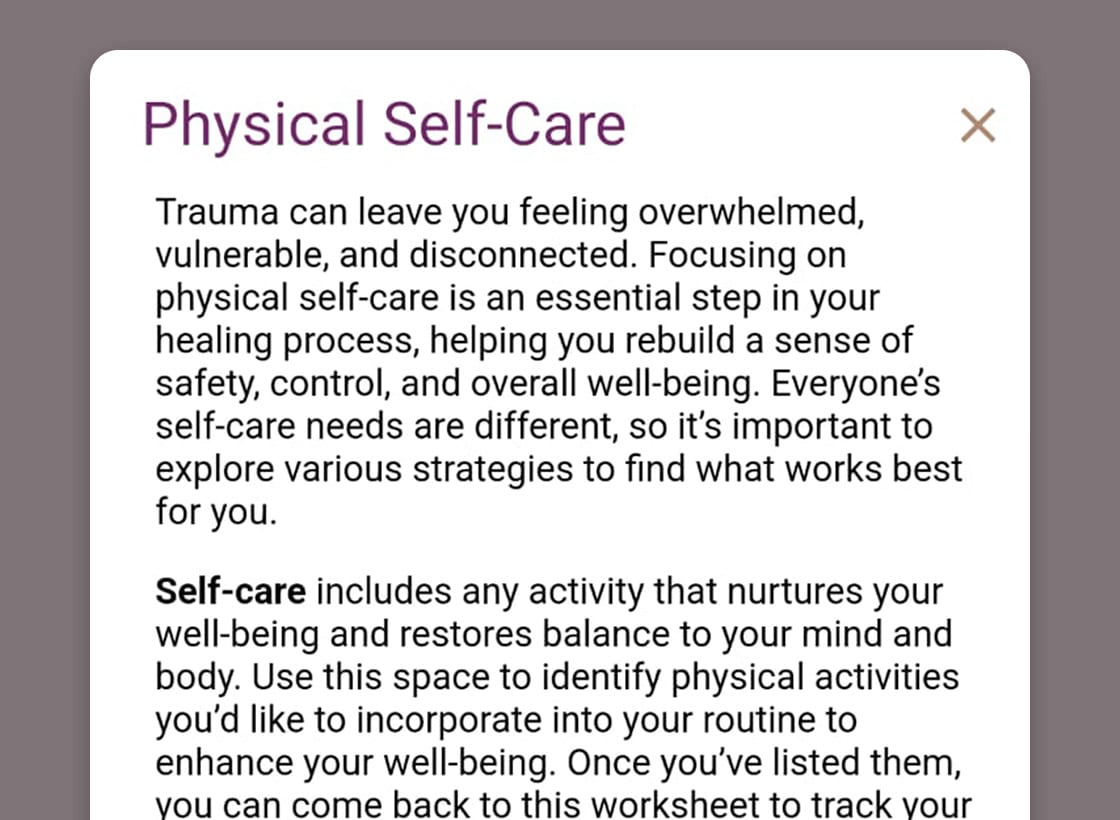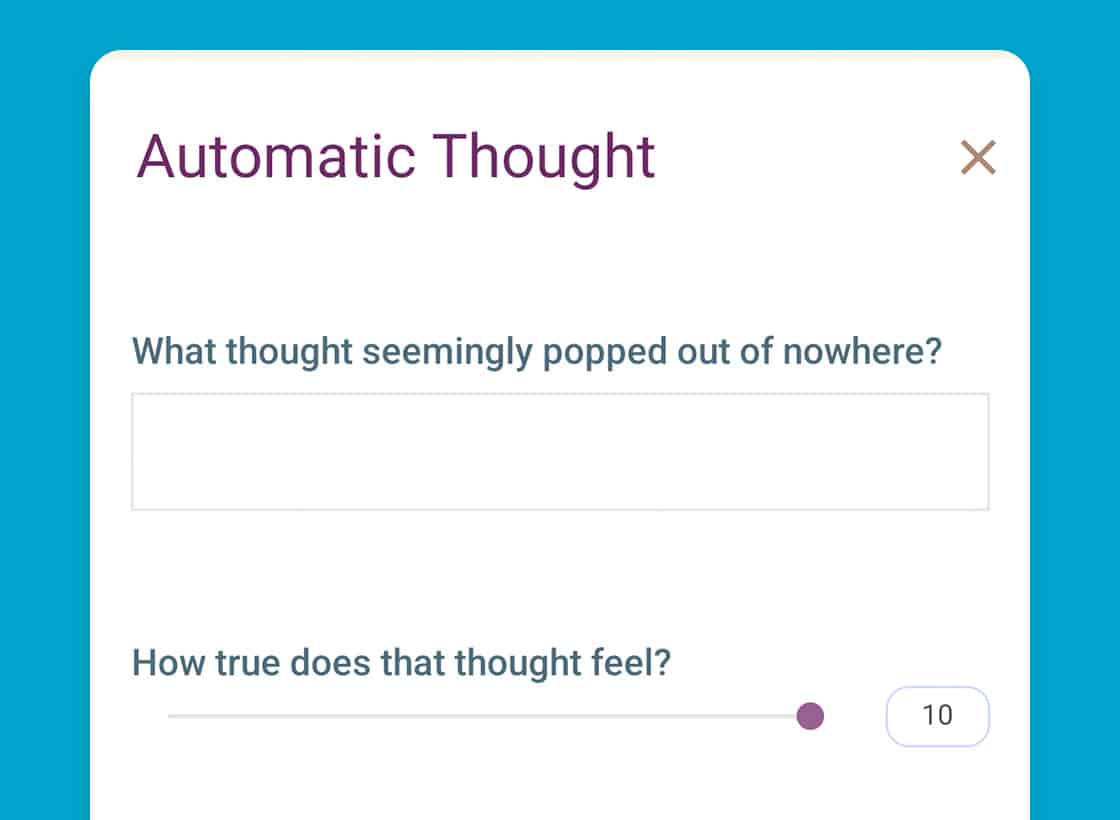Physical Self-Care
Template by Reflective
Best for Anxiety Depression PTSD CBT DBT Trauma En Eating
The “Physical Self-Care Assignment” is a practical tool designed to help clients re-engage with physical self-care activities that foster a sense of well-being and self-worth. Trauma can often leave individuals feeling too overwhelmed to prioritize self-care, but this assignment provides a structured approach to overcoming that barrier. Clients first identify physical self-care activities they wish to incorporate into their routine and then track how they feel before and after each activity. Ideal for use in Trauma-Focused Therapy, Cognitive Behavioral Therapy (CBT), Acceptance and Commitment Therapy (ACT), and Positive Psychology, this assignment supports incremental progress, builds resilience, and encourages clients to reconnect with their bodies in a healthy and empowering way.
Share the Physical Self-Care worksheet with your client
Share the Physical Self-Care worksheet with your patient with the Reflective app so they can do the work between sessions. Simply enter their email, and they’ll be able to fill in the worksheet from the convenience of their phone. Get started for free!
How does Reflective work?
Share exercise with client via Reflective
Client receives email with app link and connection request
Client clicks link to download app
Client accepts your connection and exercises you shared
Client uses app to fill in exercises, gets reminders
Table of Contents
- Introduction
- The History of Behavioral Activation
- Behavioral Activation Across Modalities
- What Disorders Benefit from Behavioral Activation?
- Physical Self-Care: The Missing Piece in Behavioral Activation
- How to Integrate Behavioral Activation into Practice
- Using Reflective for Physical Self-Care
- Addressing Therapist Self-Care
- Conclusion
Behavioral Activation and Physical Self-Care
Introduction
Behavioral Activation (BA) is a powerful therapeutic intervention that helps clients overcome emotional stagnation by encouraging meaningful activity. While BA is widely recognized for its efficacy in treating depression, its principles extend far beyond this application. One often overlooked but vital aspect is the integration of physical self-care into BA to ensure a sustainable and holistic impact.
As therapists, we constantly balance guiding our clients toward actionable change while nurturing overall well-being. This article explores Behavioral Activation’s history, its role in various modalities, the disorders and challenges it addresses, and actionable strategies to integrate it into practice. Additionally, we’ll touch on how Reflective, a tool designed to keep clients engaged between sessions, can amplify your BA strategies with tailored psychoeducation and exercises.
The History of Behavioral Activation
Behavioral Activation has its roots in the 1970s, developed as a component of Cognitive Behavioral Therapy (CBT). It was initially designed to address the behavioral patterns associated with depression, particularly inactivity and withdrawal. The logic was simple: engaging in meaningful activities would counteract the cycles of avoidance and reinforce positive emotional states.
Over the decades, researchers found that BA could stand alone as an effective evidence-based treatment for depression. Notably, Jacobson et al. (1996) demonstrated that the behavioral component of CBT alone was as effective as the full model in treating depression. Today, BA is not only a standalone intervention but also a foundational concept in other therapeutic modalities.
For an in-depth exploration, consider reading Behavioral Activation: Distinctive Features by Jonathan W. Kanter, Andrew M. Busch, and Laura C. Rusch.
Behavioral Activation Across Modalities
While BA originated within CBT, its principles permeate other therapeutic approaches.
- Acceptance and Commitment Therapy (ACT): BA aligns with ACT’s emphasis on values-based living. By identifying meaningful activities, clients learn to act in accordance with their values, even in the presence of uncomfortable emotions.
- Dialectical Behavior Therapy (DBT): In DBT, BA complements skills like mindfulness and emotion regulation by encouraging clients to schedule and commit to activities that promote mastery and pleasure.
- Mindfulness-Based Cognitive Therapy (MBCT): Combining BA with mindfulness helps clients remain present during activities, fostering a deeper sense of fulfillment.
By blending BA with these approaches, therapists can address not only avoidance behaviors but also the underlying challenges that perpetuate them.
What Disorders Benefit from Behavioral Activation?
Behavioral Activation is versatile and effective across a wide range of disorders and life challenges:
- Depression: BA is a first-line treatment for depression, breaking the cycle of inactivity and low mood. By encouraging clients to engage in activities that bring mastery and enjoyment, BA helps shift the emotional baseline.
- Anxiety: For clients with anxiety, BA reduces avoidance behaviors, helping them confront fears through gradual exposure and re-engagement with life.
- Post-Traumatic Stress Disorder (PTSD): BA aids in rebuilding structure and reintroducing meaningful activities, empowering clients to regain control over their lives.
- Burnout and Major Life Transitions: Whether a client is navigating grief, career changes, or caregiving responsibilities, BA provides a framework to re-establish balance and purpose.
Physical Self-Care: The Missing Piece in Behavioral Activation
While BA focuses on action, it’s critical to address the physical component of recovery. Physical self-care involves maintaining one’s physical health through intentional actions, which directly impacts mental well-being. However, many clients (and therapists) struggle with balancing physical self-care with the demands of daily life.
Strategies for Physical Self-Care:
- Incorporating Movement: Encourage clients to find physical activities they enjoy, such as walking, yoga, or dancing, and schedule these regularly.
- Prioritizing Rest: Help clients create habits that support quality sleep, such as consistent sleep schedules or relaxation techniques before bed.
- Focusing on Nutrition: Work with clients to identify small, achievable changes in their diet that can boost energy and mood.
Reflective can help reinforce physical self-care by providing tailored resources, such as habit trackers for movement, reminders for hydration, and psychoeducation on the connection between physical and mental health.
How to Integrate Behavioral Activation into Practice
Implementing BA into your practice doesn’t have to be complicated. Here’s a step-by-step guide:
- Assess Avoidance Patterns: Identify the specific behaviors and situations your client is avoiding. Use tools like avoidance surveys or Reflective’s symptom trackers to gather data.
- Create Value-Driven Schedules: Collaboratively design an activity schedule that incorporates both meaningful and enjoyable activities. Focus on aligning these with the client’s values.
- Reinforce Between Sessions: Reflective can enhance your BA work by:
- Providing psychoeducation on the relationship between behavior and mood.
- Delivering reminders and progress-tracking tools to keep clients engaged.
- Offering exercises, such as physical activity trackers or healthy eating plans, that align with BA goals.
- Monitor Progress: Regularly evaluate which activities resonate most with the client and adjust the plan accordingly. Use Reflective’s data to gain insights into client engagement and outcomes.
Using Reflective for Physical Self-Care
Reflective offers a specialized exercise for integrating Behavioral Activation with physical self-care. This exercise allows clients to:
- Plan Physical Self-Care Activities: Clients can fill in activities they want to introduce into their lives, such as stretching, cycling, or meal prepping.
- Track Their Progress: Once clients input their chosen activities, these choices are prepopulated for future use. They can select from their personalized list and track how they felt before and after completing each activity.
- Pair Activities with Psychoeducation: Physical self-care activities can be complemented with resources on the benefits of exercise, nutrition, and rest for mental health, creating a comprehensive approach to well-being.
This feature not only empowers clients to take ownership of their physical self-care but also provides therapists with valuable insights into client engagement and outcomes.
Addressing Therapist Self-Care
Therapists are not immune to the challenges of balancing productivity and self-care. Modeling healthy physical self-care for clients starts with integrating it into your own life.
Reflective can ease the administrative burden of therapy, freeing up time for self-care. By automating tasks like tracking, psychoeducation delivery, and session follow-ups, you can focus on maintaining your own physical health while staying present for your clients.
Conclusion
Behavioral Activation, when paired with physical self-care, provides a holistic and impactful approach to therapy. By addressing both action and physical well-being, therapists can help clients achieve meaningful and sustainable progress. Reflective offers a seamless way to integrate these principles into practice, enhancing client engagement and reducing therapist workload.
Start incorporating Behavioral Activation into your sessions today and explore how Reflective can support you in crafting personalized treatment plans that foster long-term growth.



